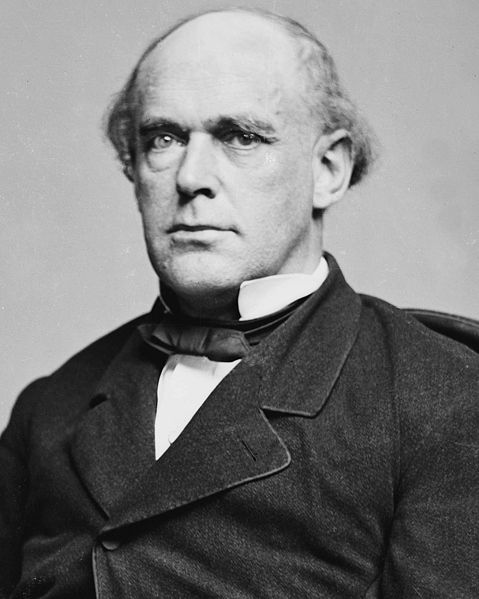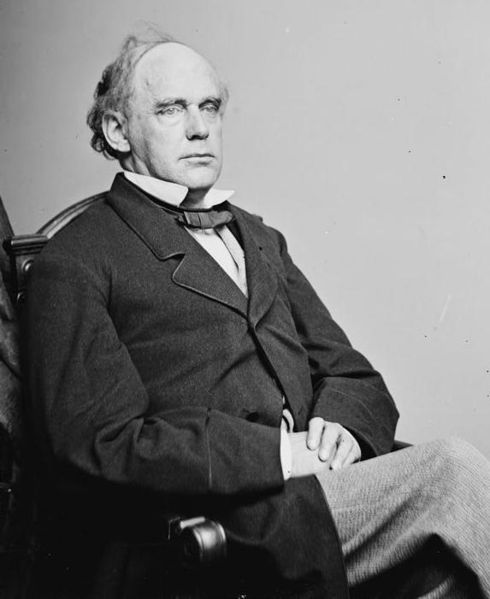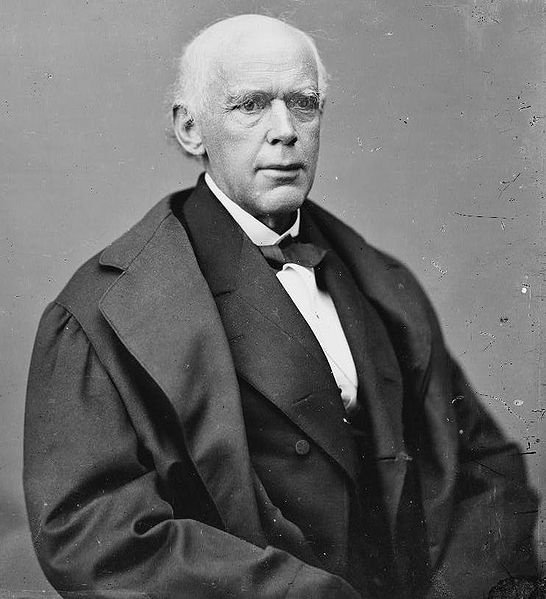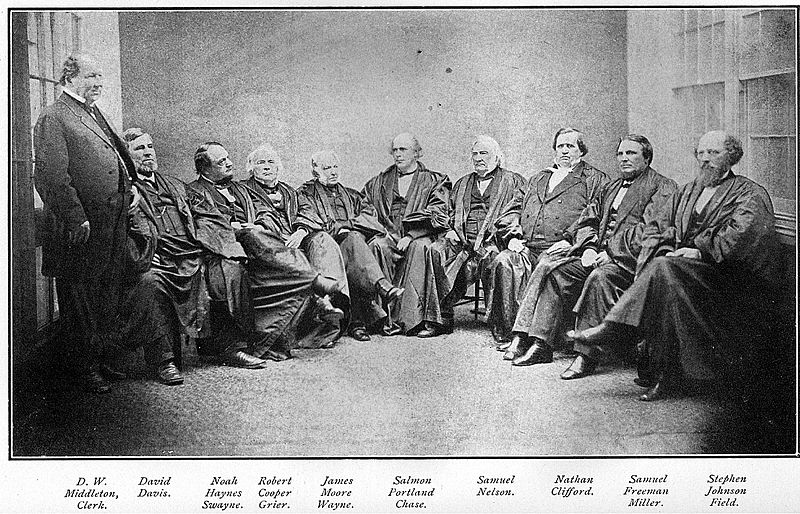<Back to Index>
- Astronomer François Félix Tisserand, 1845
- Composer Johann Christoph Graupner, 1683
- Governor of Ohio, Secretary of the Treasury and Chief Justice of the U.S. Supreme Court Salmon Portland Chase, 1808
PAGE SPONSOR


Salmon Portland Chase (January 13, 1808 – May 7, 1873) was an American politician and jurist who served as U.S. Senator from Ohio and the 23rd Governor of Ohio; as U.S. Treasury Secretary under President Abraham Lincoln; and as the sixth Chief Justice of the United States.
Chase articulated the "Slave Power conspiracy" thesis well before Lincoln. He coined the slogan of the Free Soil Party, "Free Soil, Free Labor, Free Men." He devoted his energies to the destruction of what he considered the Slave Power – the conspiracy of Southern slave owners to seize control of the federal government and block the progress of liberty. Chase was born in Cornish, New Hampshire, to
Ithamar Chase and his wife Janet Ralston. His father died when the boy
was nine years old. Janet Chase was left a widow with "a small amount
of property and ten surviving children". Salmon was raised by his uncle, Philander Chase, an Episcopal bishop. He studied in the common schools of Windsor, Vermont and Worthington, Ohio, and at Cincinnati College before entering the junior class at Dartmouth College. He was a member of the Alpha Delta Phi Fraternity and Phi Beta Kappa, and graduated from Dartmouth in 1826. While at Dartmouth, he taught at the Royalton Academy in Royalton, Vermont. Chase moved to the District of Columbia, where he studied law under U.S. Attorney General William Wirt and continued to teach. He was admitted to the bar in 1829. In 1830, Chase moved to Cincinnati, Ohio,
where he quickly gained a position of prominence at the bar. He
published an annotated edition of the laws of Ohio which was long
considered a standard. The death of his first wife in 1835 triggered
Chase's spiritual reawakening and devotion to causes more aligned with
his faith, including abolition. He worked initially with the American Sunday School Union and began defending fugitive slaves. At a time when public opinion in Cincinnati was dominated by Southern business connections, Chase, influenced by local events, including the attack on the press of James G. Birney during the Cincinnati Riots of 1836, associated himself with the anti-slavery movement. Chase was also a member of the literary Semi-Colon Club, whose members included Harriet Beecher Stowe and Calvin Stowe. Chase became the leader of the political reformers, as opposed to the Garrisonian abolitionist movement. For his defense of escaped slaves seized in Ohio under the Fugitive Slave Law of 1793, Chase was dubbed the Attorney General for Fugitive Slaves. His argument in the case of Jones v. Van Zandt on the constitutionality of fugitive slave laws before the U.S. Supreme Court attracted particular attention. In this and similar cases, the court ruled against him, and John Van Zandt's conviction was upheld. Chase contended that slavery was local, not
national, and that it could exist only by virtue of positive state law.
He argued that the federal government was not empowered by the Constitution to
create slavery anywhere and that when a slave leaves the jurisdiction
of a state where slavery is legal, he ceases to be a slave; he
continues to be a man and leaves behind the law that made him a slave. Elected as a Whig to the Cincinnati City Council in 1840, Chase left that party the next year. For seven years he was the leader of the Liberty Party in
Ohio. He helped balance its idealism with his pragmatic approach and
political thought. He was skillful in drafting platforms and addresses,
and he prepared the national Liberty platform of 1843 and the Liberty
address of 1845. Building the Liberty Party was slow going. By 1848
Chase was leader in the effort to combine the Liberty Party with the Barnburners or Van Buren Democrats of New York to form the Free Soil Party. Chase drafted the Free - Soil platform, and it was chiefly through his influence that Van Buren was
their nominee for President in 1848. In 1849, Chase was elected to the
U.S Senate from Ohio on the Free Soil ticket. Chase's goal, however,
was not to establish a permanent new party organization, but to bring
pressure to bear upon Northern Democrats to force them to oppose the extension of slavery. During his service in the Senate (1849 – 1855), Chase was an anti-slavery champion. He spoke ably against the Compromise of 1850 and the Kansas - Nebraska Act of 1854. The passage of the Kansas - Nebraska legislation, and the subsequent violence in Kansas, convinced Chase of the futility of trying to influence the Democrats. He
was a leader in the movement to form a new party opposing the extension
of slavery. He tried to unite the liberal Democrats with the dwindling
Whig Party, which led to establishment of the Republican Party.
"The Appeal of the Independent Democrats in Congress to the People of
the United States", written by Chase and Giddings, and published in the New York Times on January 24, 1854, may be regarded as the earliest draft of the Republican party creed. In
1855 he was elected governor of Ohio. Chase was the first Republican
governor of Ohio, serving from 1856 to 1860, where he supported women's
rights, public education, and prison reform. Chase sought the Republican nomination for president in 1860. With the exception of William H. Seward,
Chase was the most prominent Republican in the country and had done
more against slavery than any other Republican. But he opposed a "protective tariff",
favored by most other Republicans, and his record of collaboration with
Democrats annoyed many Republicans who were former Whigs. At the 1860 Republican National Convention, he got 49 votes on the first ballot, but he had little support outside Ohio. Abraham Lincoln won the nomination, and Chase supported him. Chase was elected as a Republican to the U.S. Senate in 1860. However, three days after taking his seat, he resigned to become Secretary of the Treasury under Lincoln. He was member of the Peace Convention of 1861 held in Washington, D.C., in an effort to prevent the impending war.
Chase served as Secretary of the Treasury in President Lincoln's cabinet from 1861 to 1864, during the Civil War.
In that period of crisis, there were two great changes in American
financial policy, the establishment of a national banking system and
the issue of paper currency.
The former was Chase's own particular measure. He suggested the idea,
worked out the important principles and many of the details, and
induced the Congress to
approve them. It not only secured an immediate market for government
bonds, but also provided a permanent uniform, stable national currency.
Chase ensured that the Union could sell debt to pay for the war effort.
He worked with Jay Cooke & Company to successfully manage the sale of $500 million in government war bonds (known as 5/20s) in 1862.
The first U.S. federal currency, the greenback
demand note,
was printed in 1861 - 1862, during Chase's tenure as Secretary of the
Treasury. It was his responsibility to design the notes. In an effort
to further his political career, his face appeared on a variety of U.S.
paper currency, starting with the $1 bill so that the people would
recognise him. Perhaps Chase's chief defect was an insatiable desire for high office. Throughout
his term as Treasury Secretary, Chase exploited his position to build
up political support for another run at the Presidency in 1864. He
also tried to pressure Lincoln by repeatedly threatening resignation,
which he knew would cause Lincoln difficulties with the Radical
Republicans. To honor Chase for introducing the modern system of banknotes, he was depicted on the $10,000 bill printed from 1928 to 1946. Chase was instrumental in placing the phrase "In God We Trust" on United States coins. In
June 1864, Lincoln surprised Chase by accepting his fourth offer of
resignation; Lincoln had secured renomination and the Federal Treasury
was in solid shape, so Lincoln no longer needed Chase. But to placate the Radical wing of the party, Lincoln mentioned Chase as a potential Supreme Court nominee. When Chief Justice Roger B. Taney died
in October, Lincoln named Chase to replace him. Lincoln issued on the
nomination on December 6, 1864. Chase was confirmed by the Senate that
very day, and immediately received his commission, holding the office
from 1864 until his own death in 1873. Chase was a complete change from
the pro-slavery Taney; one of Chase's first acts as Chief Justice was
to admit John Rock as the first African - American attorney to argue cases before the Supreme Court. In his capacity as Chief Justice, Chase presided at the impeachment trial of President
Andrew Johnson in 1868. Among his most important decisions while on the court were: Toward
the end of his life he gradually drifted back toward his old Democratic
allegiance, and made an unsuccessful effort to secure the Democratic
nomination for the presidency in 1868. He "was passed over because of
his stance in favor of voting rights for black men." He helped to found the Liberal Republican Party in 1872, unsuccessfully seeking its presidential nomination. Chase was also a Freemason, active in the lodges of Midwestern society. He collaborated with John Purdue, the founder of Lafayette Bank and Purdue University. Eventually, JP Morgan Chase & Co. would purchase Purdue National Corporation of Lafayette, Indiana in 1984. As early as 1868 Chase concluded that: Chase died in New York City in 1873. His remains were interred first in Oak Hill Cemetery in Washington, D.C., and later reinterred in Spring Grove Cemetery, Cincinnati, Ohio. Chase had been an active member of St. Paul Episcopal Cathedral, Cincinnati. The Chase National Bank, a predecessor of Chase Manhattan Bank which is now JP Morgan Chase, was named in his honor, though he had no financial affiliation with it. Chase Hall, the main barracks and dormitory at the United States Coast Guard Academy, is named for Chase in honor of his service as Secretary of the Treasury, and the United States Coast Guard Cutter Chase (WHEC 718) is named for him. Chase's portrait is on the $10,000 bill, but it is out of circulation. Chase County, Kansas, is named in his honor. As is Chaseville, Florida, Massachusetts, North Carolina (which only lasted from 1868 - 1871), New York, Ohio, and Tennessee.

